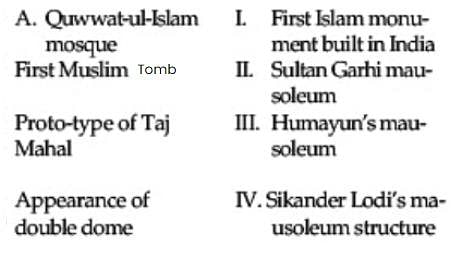Test: Indo Islamic Culture - 1 - UPSC MCQ
30 Questions MCQ Test - Test: Indo Islamic Culture - 1
What led to the growth of a composite or IndoIslamic culture?
| 1 Crore+ students have signed up on EduRev. Have you? Download the App |
The neo-technology brought by the Turks led to the rise of a new social group. Identify it.
The most important factor for the growth of purdah, in all probability, was that
Which statement/s is/are correct?
I. The Hindu and Muslim upper classes did not have much social intercourse between them in the Sultanate period.
II. The Hindu upper castes applied to the Muslims the restrictions they applied to the Shudras.
III. Caste restrictions had not closed social intercourse between the Muslims and the upper caste Hindus and the Shudras.
Which of the following customs was followed by both Hindus and Muslims?
Indo-Islam culture is best represented by what aspect of the Sultanate period?
Which statement/s is/are correct?
I. The ceremonies connected with the worship of Muslim saints are more Indian than Islamic in details.
II. Casteism began appearing in Muslim society.
III. Some aristocratic Muslim families adopted the Hindu custom of sati and jauhar.
Most of the Islamic architecture in India is composed of masonry formed of
The mosque and the tomb belong to which conventional style of architecture?
Many temples were converted into mosques.One such was a Jain temple first and it is the earliest known mosque in India. Identify
Which of the following architectural works was formerly a monastery?
Which of the following began to be used on a large scale in architecture in India with the coming of the Turks?
The Qutb Minar was completed by Iltutmish. It was dedicated to
The entrance door to the Qutb Minar called the Alai Darwaza was built by
A structure contains a dome which, for the first time, was built on correct scientific lines. Identify it.
The fortress of Adilabad and the city of Jahanpanah were built by
The tomb of a Tughlaq ruler marked a new trend in architecture. To have a good skyline, the tomb was put up on a high platform. Its beauty was heightened by a marble dome. Identity the ruler.
Match the dynasties of Sultanates with the cities they built:
Horse shoe arch is distinctive feature of one of the following buildings. Identify it.
Match the dynasties or kings with the coins they issued:
An Arabic inscription on the walls of one of the following buildings states that the material of twenty seven temples was used in its contruction. Identify the structure.
Sloping walls (batter) was a striking feature of Tughlaq architecture. It was absent in the buildings of
A feature of Tughlaq architecture was the deliberate attempt to combine the principles of the arch and the lintel and beam in their buildings.This is found in a marked manner in the buildings of
The decorative design found in all the buildings of Firuz Tughlaq is
Balconies, kiosk and caves of the Rajasthani-Gujarati style are used in the building of


















